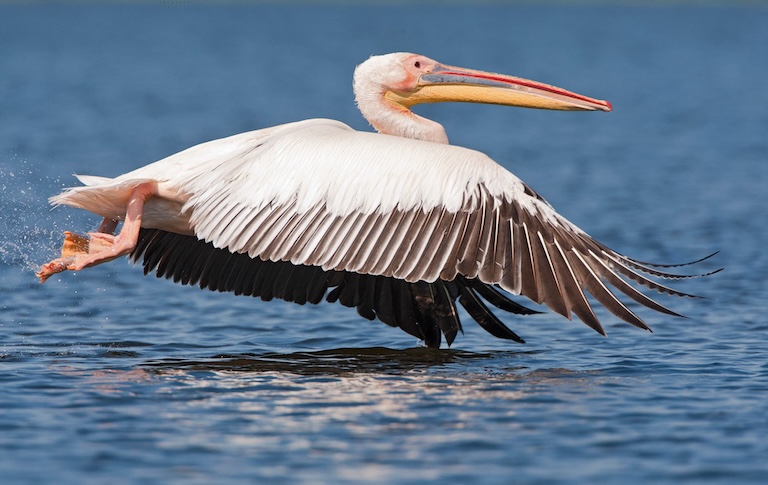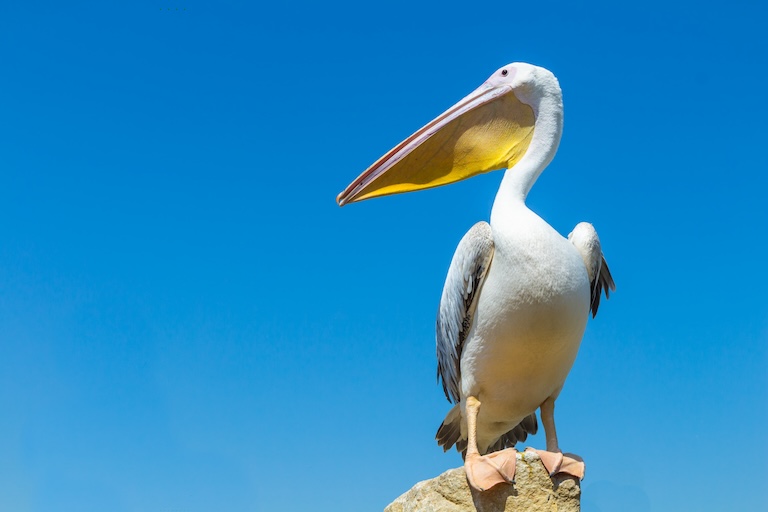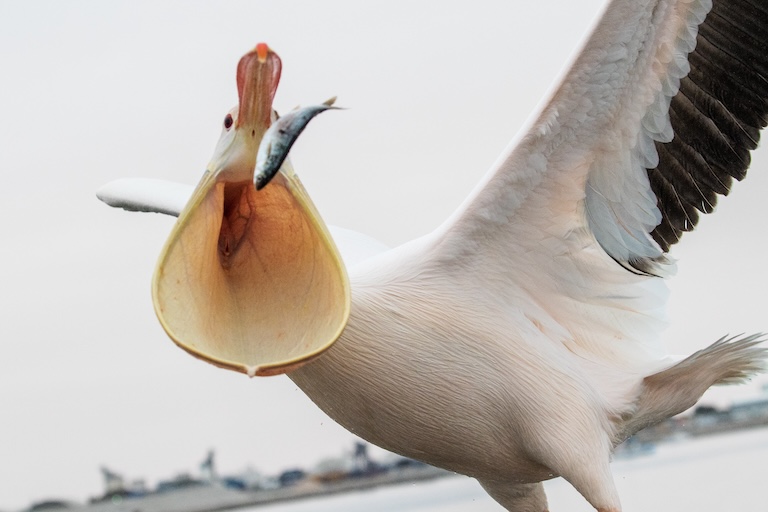Great White Pelican Profile
When the book Jaws was first pitched to the publishers, Peter Benchley presented the idea of a colossal and ancient marine predator with cold, dead eyes, an enormous, man-eating gape and the terrifying ability to descend silently upon Chrissy Watkins, devouring her without mercy.
The great white pelican was ideal as the antagonist of the story, but the publishers, in their folly, misread the manuscript and we ended up with Bruce the shark.
Still, this is a stone-cold killer of a bird, its derpy appearance belying its undoubtable potential to terrorise a small beach resort town.

Great White Pelican Facts Overview
| Habitat: | Warm, shallow freshwater, brackish, alkaline or saline lakes, lagoons, marshes, rivers, etc. |
| Location: | Africa, Israel, and Europe, Asia |
| Lifespan: | 28 in the wild, 51 in captivity |
| Size: | 175 cm (69 in) long |
| Weight: | 9 to 15 kg (20 to 33 lb) |
| Colour: | Mostly white with black flight feathers and an orange bill |
| Diet: | Mostly fish, also birds, or any animal they can fit into their mouth |
| Predators: | Jackals, hyenas, lions, and eggs may be eaten by foxes and smaller birds |
| Top Speed: | 44.5 km/h |
| No. of Species: | 1 |
| Conservation Status: | Least Concern |
Pelicans are enormous, heavy-flying water birds.
They are well known for having a neck pouch you could swing a cat in, but while they’re historically portrayed as pleasant animals, these ancient birds are top predators, with few enemies in their adult stages, and contribute to fish massacres in the tens of millions of kilograms.
And it’s not only fish they’ll eat: chicks, rodents, and Australian weathermen are also at risk.
Interesting Great White Pelican Facts
1. They’re Pelecaniformes
Pelicans are members of the Pelecaniformes, or “pelican-shaped” bird order, which isn’t very surprising since they’re the most pelican-shaped birds in the world.
This order also contains herons, ibises and spoonbills, but the pelican’s closest relatives are the shoebills and the hamerkops.
Within this order, the pelicans form the Pelecanidae family, consisting of three known genera, two of which are now extinct. This leaves us with only one to choose from: Pelecanus, which sounds like something you should go to the doctor for.
Like the mouth of a whale, the pelicans have a large throat pouch used for catching prey and draining water out of it before swallowing, and of them all, the great white pelican is the grand-daddy pelican, weighing up to 15 kg.

2. They’re huge
This is a lot of mass for a bird that can fly, and only a few birds, including the bustard have it beat. The Dalmatian pelican is slightly bigger but not heavier than this bird, which reaches up to 18 metres long with a 3.6-metre wingspan.
Only the great albatross has a longer reach.
3. They change colour
These enormous animals are very communicative. Sound, movement and posture all play a role in getting its point across and grunting, baying, and mooing are common utterances from the bird.
Baying and mooing in particular are considered sexy noises in the pelican world, and used to impress a mate. This doesn’t work as well in human interactions though, outside of a small subcommunity of people who wear rabbit ears on the daily.
Like an ageing animal blogger getting out of an armchair, the great white pelicans are known to grunt as they take off, but only when it’s around other people – they’re generally silent when alone.
One of the clearest mating signals, though, is their colour. When it’s time to bump uglies, these pelicans’ feathers change from white to pinkish, the colour of love. 1
4. They travel
Towards the Autumn, the pelicans will set off on a migration that will take them across long distances in huge groups. The group size correlates with the length of the journey, and there can be more than 60 of these massive birds in a flock.
They can travel up to 160 km a day, which is not bad for such a fatty, and they may pick up more along the way.
The huge mass of the bird makes them clumsy at taking off and landing, but the enormous wings are great for catching thermals. Their V-shape formations are instantly recognisable and work to synchronise flapping efforts and make locomotion more efficient for everyone.
Despite being so distinctive, the migration paths aren’t fully mapped out for this species, but it’s known that some populations migrate to Eastern Europe from Kazakhstan and back and that many overwinter in North India and North Africa.
After overwintering, they’ll return to breeding colonies for the warmer months. This is a very widespread and abundant bird, found in much of Africa, Europe and Asia, and in populations in the tens of thousands.
Their large size and unusual character have made them a pop culture favourite, but unlike the dental aficionado Nigel in Finding Nemo, real pelicans are actually rather terrifying.
5. They’re monstrous
As we’ve covered, pelicans are enormous. But while they may be depicted as helpers of fish in popular animated movies, they are in fact, cold-blooded killers.
They mostly eat fish, but they will take on anything they can swallow, something which is corroborated via multiple badly narrated YouTube videos showing pelicans eating pigeons and ducklings, drowning gulls and attacking cats; and even having a go at capybaras and Australian weathermen.
Still, fish are its food of choice, and they can really do a number on them. 2

6. They get through a lot of fish
The large throat pouch on the pelican is used as a sort of net to scoop up food and position it to slip down their wide throat.
A single great white pelican can eat around 1.5 kg of fish per day just for maintenance, and given their number at Tanzania’s Lake Rukwa, this amounts to 28,000,000 kg a year from this single population.
A group of around 7 pelicans will team up, dipping their scoops into the water in a horseshoe formation, encircling fish with their pouches and schooling them into their mouths. 3
Great White Pelican Fact-File Summary
Scientific Classification
| Kingdom: | Animalia |
| Phylum: | Chordata |
| Class: | Aves |
| Order: | Aequornithes |
| Family: | Pelicanidae |
| Genus: | Pelecanus |
| Species: | onocrotalus |
Fact Sources & References
- Emily Campbell, “Pelecanus onocrotalus great white pelican”, Animal Diversity Web.
- CBS (2015), “Pelican Attacks Aussie Weatherman”, YouTube.
- L. H. Brown (1969), “THE BREEDING BIOLOGY OF THE GREAT WHITE PELICAN PELECANUS ONOCROTALUS ROSEUS AT LAKE SHALA”, Wiley Online Library.
